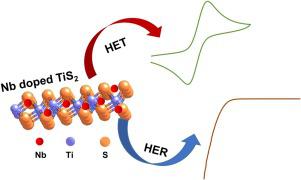Applied Materials Today ( IF 7.2 ) Pub Date : 2020-01-25 , DOI: 10.1016/j.apmt.2020.100555 Elham Rahmanian , Carmen C. Mayorga-Martinez , Nasuha Rohaizad , Jan Luxa , Zdenek Sofer , Martin Pumera

|
Transition metal dichalcogenide layered structures have become the focus of special attention for electrochemical applications in recent years. Although various engineering strategies, including size reduction and composition manipulation, have been adopted to modulate the innate electrochemical features of these layered materials, there remains a great deal of work to satisfy the specific requirements for practical applications. In this work, we set forth to provide an insight into the impact of niobium (Nb) doping on the structural features of titanium disulfide (TiS2). In addition, we examine the influence of Nb dopant on the inherent electrochemistry and charge transfer kinetics of TiS2 and its implication for the hydrogen evolution, oxygen reduction and oxygen evolution reaction (HER, ORR, and OER) processes. It has been found that introducing an appropriate amount of Nb atom (>10%) results in the formation of titanium trisulfide (TiS3) belt-like structures on the surface of TiS2 polygonal discs. Nb doping marginally changes the inherent electroactivity of TiS2 through introducing a small trace of reducible species. Furthermore, Nb-doped TiS2 materials show improved electron transfer kinetics when compared to pure TiS2, with the fastest of 5.58 × 10−4 cm s−1 toward [Fe(CN)6]3−/4− redox probe recorded for Ti0.95Nb0.05S2. The same trend is also found in the HER activity of these materials whereby Nb-doped TiS2 materials exhibit better performance in the electrocatalytic hydrogen evolution.
中文翻译:

层状二硫化钛中铌掺杂引起的结构转变:对电催化性能的影响
近年来,过渡金属二硫化氢层状结构已成为电化学应用中特别关注的焦点。尽管已采用各种工程策略,包括尺寸减小和成分操纵来调节这些层状材料的固有电化学特征,但仍需要大量工作来满足实际应用的特定要求。在这项工作中,我们着手提供有关铌(Nb)掺杂对二硫化钛(TiS 2)结构特征的影响的见解。此外,我们研究了Nb掺杂剂对TiS 2固有的电化学和电荷转移动力学的影响及其对氢释放,氧还原和氧释放反应(HER,ORR和OER)过程的启示。已经发现引入适量的Nb原子(> 10%)导致在TiS 2多边形盘的表面上形成三硫化钛(TiS 3)带状结构。Nb掺杂通过引入少量痕量的可还原物质来稍微改变TiS 2的固有电活性。此外,与纯TiS 2相比,掺Nb的TiS 2材料显示出改善的电子传输动力学,对于Ti 0.95 Nb 0.05 S 2记录的5.58×10 -4 cm s -1朝向[Fe(CN)6 ] 3- / 4-氧化还原探针。在这些材料的HER活性中也发现了相同的趋势,其中掺Nb的TiS 2材料在电催化制氢方面表现出更好的性能。











































 京公网安备 11010802027423号
京公网安备 11010802027423号